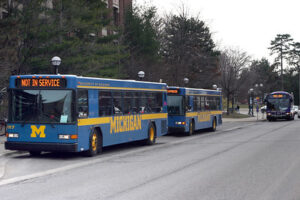Yesterday, I wrote about the Michigan Achievement Scholarship and the framing that WCC uses for the offering. In the most recent issue of “On the Record,” WCC claims that the scholarship is sufficient to pay for WCC’s tuition for a full-time student.
At WCC, three-fourths of students attend classes only part-time. They would have real problems shifting to full-time school attendance. As a result, most students will not be able to take advantage of the opportunity. In addition, there are other conditions that students must be aware of with this scholarship.
Michigan Achievement Scholarship gotchas
The Michigan Achievement Scholarship has a total of five years of eligibility. According to the legislation that created the program, a student can spend only three of those five years at a community college. This could have a significant impact on students who intend to transfer to a four-year institution.
The community college scholarship pays a maximum of $8,250 over the course of three years. A transfer student could use the remaining two years of eligibility, and potentially receive an additional $11,000 in aid. Using this approach, the student’s maximum aid would be $19,250. On the other hand, if a student starts at a four-year, public university, the program could provide maximum aid of $27,500 over the same five years. A community college transfer student can lose as much as $8,250 of grant aid. From a financial perspective, it does not make sense for a student using this program to transfer to a four-year university from a community college.
Unfortunately, community colleges have no incentive to be truthful with prospective students. To boost their own enrollment, community colleges would willingly allow a student to burn as much as three years of their five-year window of opportunity under this program.
There’s one other little wrinkle: students cannot attend more than one eligible institution in an academic year and still receive the award. That means December graduates must either wait a semester to enroll, or they will need to go without the MAS scholarship for a while.
Other restrictions WCC students should know about
The Michigan Achievement Scholarship is available only to students attending Michigan colleges and universities. This isn’t a disadvantage, but it does limit where and how the student can use the scholarship.
The MAS program is open only t o students whose Expected Family Contribution (EFC), as determined by The FAFSA, is $25,000 or less. The EFC is highly individualized, but households with incomes of $125,000 could be excluded from participating.
T
Students can lose their MAS funds by not completing “sufficient academic progress” as defined by the institution they’re attending. Once a student has lost the scholarship, s/he cannot recover it.
Higher education institutions must practice “tuition restraint.” Institutions that raise their tuition and fees by more than 5% in a year will be excluded from participating. In WCC’s case, this would be an increase of $7 per credit hour from its current tuition rate. I said yesterday that I thought the chances of students escaping a tuition increase at WCC in the upcoming year were slim. The tuition restraint requirement may actually encourage schools to raise tuition to the maximum allowable rate each year.
As usual, the devil is in the details. Some of these restrictions may impact students who would otherwise be eligible for the program. It’s important for WCC to be transparent regarding its participation, but if the past is any indication, that will be a tall order.
Photo Credit: Doug Kaye, via Flickr













